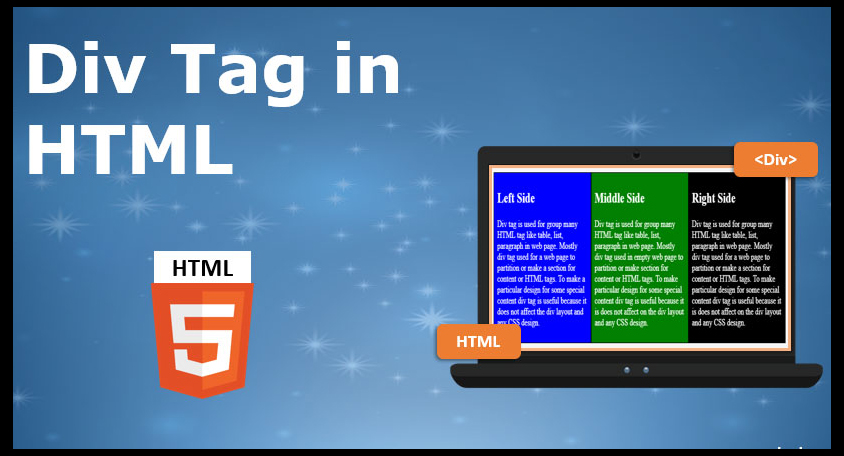The internet has fundamentally transformed the way we live, work, and communicate. As the digital landscape continues to evolve, websites have become essential tools for individuals, businesses, and organizations worldwide. Web design, once a niche field, has grown into a dynamic industry, offering endless possibilities for creativity and functionality. In this article, we will explore the evolution of web design and the role of div tags in creating modern and responsive websites.
The Dawn of Web Design
In the early days of the World Wide Web, websites were rudimentary and often resembled digital brochures. They were primarily static, composed of simple HTML pages with minimal interactivity. Design options were limited, and web designers relied on basic HTML elements to structure content.
The Rise of CSS and Layouts
The late 1990s witnessed a significant shift in web design with the introduction of Cascading Style Sheets (CSS). CSS allowed designers to separate content from presentation, enabling greater control over a website’s appearance. This innovation led to the emergence of more sophisticated layouts and designs. Tables, once the go-to choice for structuring web content, began to give way to CSS-based layouts.
The Role of Div Tags
Div tags, short for division tags, played a pivotal role in this transition. These HTML elements allowed web designers to create flexible and versatile layouts by dividing web pages into logical sections. Div tags served as containers for content, making it easier to apply styles and formatting.
Each div tag could be uniquely identified using the “id” attribute, enabling precise targeting of styling rules through CSS. This granular control over the presentation of web content was a game-changer, as it paved the way for responsive design – the ability to adapt a website’s layout to different screen sizes and devices.
Responsive Web Design
The proliferation of smartphones and tablets in the early 21st century brought about a new challenge for web designers: ensuring that websites looked and functioned well on a variety of screens. Responsive web design became the solution.
Div tags, in conjunction with CSS media queries, allowed designers to create fluid and adaptable layouts. Media queries detect the characteristics of the user’s device, such as screen width, and apply specific styles accordingly. This approach revolutionized web design by eliminating the need for separate mobile websites.
HTML5 and Modern Web Development
The release of HTML5 marked another significant milestone in web development. HTML5 introduced new structural elements that simplified the creation of web pages. Elements like “header,” “nav,” “section,” and “article” provided semantic meaning to web content, enhancing accessibility and search engine optimization (SEO).
Div tags remained an integral part of web design, complementing these new structural elements. Web designers continued to use div tags to create custom layouts and organize content within HTML5 documents. The flexibility of div tags made it possible to achieve complex designs while adhering to web standards.
The Role of JavaScript and jQuery
In addition to HTML and CSS, JavaScript played a crucial role in enhancing the interactivity and functionality of websites. JavaScript frameworks like jQuery simplified common tasks such as DOM manipulation and event handling. With jQuery, web designers could create dynamic user experiences without extensive coding.
Div tags often served as targets for JavaScript interactions. For example, a div tag could be used to create a modal dialog box that displayed additional content when clicked. This level of interactivity enriched the user experience and contributed to the evolution of web design.
Content Management Systems (CMS)
The advent of content management systems like WordPress, Drupal, and Joomla further democratized web design. These platforms allowed individuals and businesses to create and manage websites without extensive coding knowledge. CMS templates and themes often relied on div tags for layout customization.
Div tags within CMS templates provided placeholders for dynamic content, ensuring consistency across different web pages. This approach simplified the process of adding and editing content, making it accessible to a broader audience.
The Mobile-First Approach
As mobile devices continued to dominate internet usage, web designers embraced a “mobile-first” approach. This strategy involved designing websites with mobile users in mind from the outset. Div tags, in conjunction with responsive design principles, played a crucial role in optimizing websites for mobile viewing.
By prioritizing mobile responsiveness, designers ensured that websites looked and performed well on smartphones and tablets. This approach became essential for reaching a broader audience and improving user engagement.
E-commerce and Online Shopping
The rise of e-commerce transformed web design practices, emphasizing the importance of user experience and conversion optimization. Online retailers leveraged div tags and CSS to create visually appealing product listings, streamlined checkout processes, and persuasive call-to-action buttons.
Div tags facilitated the organization of product catalogs, allowing shoppers to browse categories, view product details, and add items to their carts seamlessly. The ability to customize layouts and styles with div tags played a crucial role in differentiating e-commerce websites and driving sales.
The Impact of Social Media and Multimedia
The integration of social media and multimedia elements, such as videos and interactive graphics, became increasingly common in web design. Div tags provided a structured framework for embedding and styling these elements within web pages.
For example, a div tag could enclose a video player, allowing for precise control over its dimensions and positioning. CSS properties applied to div tags enabled designers to create visually appealing overlays, hover effects, and animations, enhancing the overall user experience.
Accessibility and Inclusivity
Web accessibility gained prominence as a fundamental aspect of web design. Div tags, when used responsibly, contributed to creating accessible websites. Designers could ensure that web content was perceivable, operable, and understandable for users with disabilities.
By adhering to accessibility guidelines and leveraging div tags for semantic structuring, designers enhanced the usability of websites for individuals with visual, auditory, motor, and cognitive impairments. This commitment to inclusivity reflected a broader recognition of the internet as a vital resource for all.
Search Engine Optimization (SEO)
Search engine optimization remained a crucial consideration for web designers and content creators. Div tags played a role in optimizing web pages for search engines by enabling the creation of well-structured and semantically meaningful content.
Using div tags to organize content into headers, sections, and articles signaled the hierarchy and importance of information to search engine crawlers. Properly structured web pages improved indexing, ranking, and visibility in search engine results pages (SERPs).

